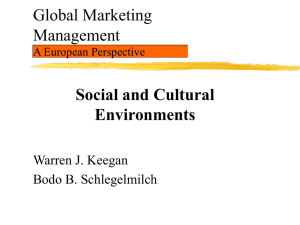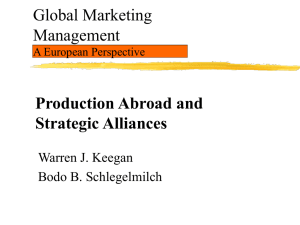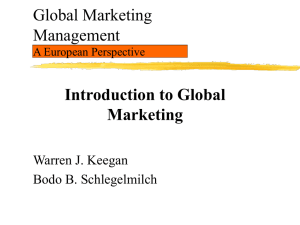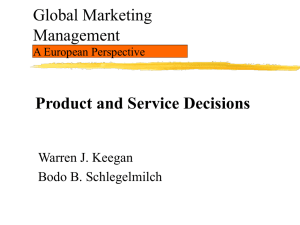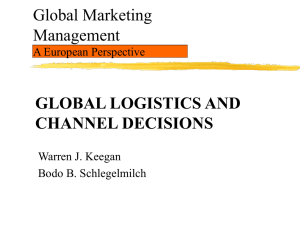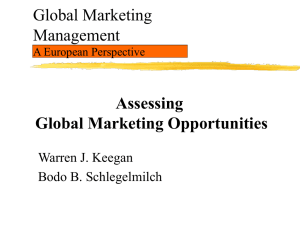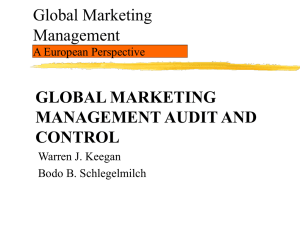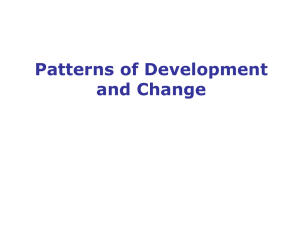Chapter 2 - MBA Program Resources
advertisement
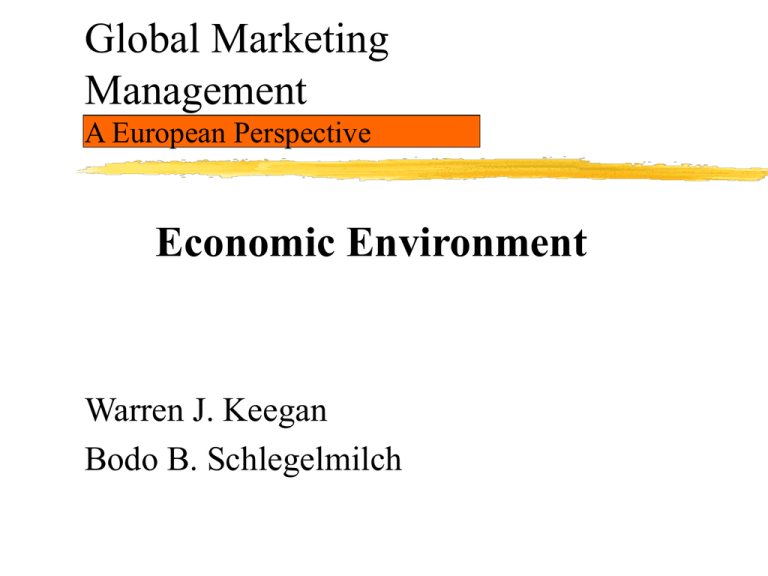
Global Marketing Management A European Perspective Economic Environment Warren J. Keegan Bodo B. Schlegelmilch Overview The World Economy – An Overview Economic Systems Stages of Market Development Income and Purchasing Power Parity Regionalisation of Markets Summary Keegan/Schlegelmilch Global Marketing Management: A European Perspective Chapter 2/ 2 Learning Objectives Understanding the main differences between economic systems found around the world Learning ways of classifying countries by their market development Understanding consumption patterns in different countries Knowing the main regional economic co-operation agreements Keegan/Schlegelmilch Global Marketing Management: A European Perspective Chapter 2/ 3 The World Economy - Overview World Economy has changed profoundly during the last 50 years Emergence of global markets Integration of world economy Capital movements are driving force of world economy Production is “uncoupled” from employment Macroeconomics of individual countries no longer control economic outcomes Keegan/Schlegelmilch Global Marketing Management: A European Perspective Chapter 2/ 4 Economic Systems Three types of economic systems Capitalist Socialist Mixed Classification based on dominant method of resource allocation Market allocation Command or central plan allocation Mixed allocation Keegan/Schlegelmilch Global Marketing Management: A European Perspective Chapter 2/ 5 Economic Systems – Market Allocation Relies upon consumers to allocate resources: “Economic Democracy” Role of state Promote competition Ensure customer protection Examples of predominately market economies Western European Countries, United States, Japan Keegan/Schlegelmilch Global Marketing Management: A European Perspective Chapter 2/ 6 Economic Systems – Command Allocation State has broad powers to serve public interest Decides which products to make Decides how to make them Elements of marketing mix are not used as strategic variables Examples of countries that relied upon command allocation systems for decades China, former USSR, India Keegan/Schlegelmilch Global Marketing Management: A European Perspective Chapter 2/ 7 Economic Systems – Mixed Systems There are in reality no pure market or command allocation systems among the world’s economies Variables to determine degree of economic freedom Trade policy Taxation policy Government consumption of economic output Monetary policy Capital flows Foreign investment Banking policy Wage and price controls Property rights Etc. Keegan/Schlegelmilch Global Marketing Management: A European Perspective Chapter 2/ 8 Economic Systems Index of Economic Freedom (Source: Heritage Foundation) Free: E.g., Hong Kong, Singapore, US, Japan, UK, Taiwan, Bahrain Mostly Free E.g., Canada, Germany, Austria, Estonia, France, Sweden, Hungary Mostly Unfree E.g., Turkey, Mexico, Israel, Malta, Russia, Bulgaria, Philippines Repressed E.g., North Korea, Haiti, Moldova, Angola, Cuba Keegan/Schlegelmilch Global Marketing Management: A European Perspective Chapter 2/ 9 Stages of Market Development Global country markets are at different stages of development GNP per capita provides a useful way of grouping countries into 5 categories Categories are a useful basis for Global segmentation Target marketing Keegan/Schlegelmilch Global Marketing Management: A European Perspective Chapter 2/ 10 Stages of Market Development – High Income Countries GNP per capita above € 7,960 (E.g., Japan, Sweden) “Post-Industrial Countries” Ascendancy Of knowledge over capital as key strategic resource Of intellectual technology over machine technology Of scientists and professionals over engineers and semiskilled workers Orientation toward the future Importance of interpersonal relationships Keegan/Schlegelmilch Global Marketing Management: A European Perspective Chapter 2/ 11 Stages of Market Development – Upper Middle Income Countries GNP per capita between € 2,575 and € 7,960 (E.g., Malaysia) Characteristics Rising wages High rates of literacy Advanced education Upper middle income countries Experience rapidly, export-driven economic growth Become formidable competitors Keegan/Schlegelmilch Global Marketing Management: A European Perspective Chapter 2/ 12 Stages of Market Development – Lower Middle Income Countries GNP per capita between € 650 and € 2,575 (E.g., Indonesia) Characteristics Early stages of industrialization Expanding consumer markets Major competitive advantage in the production of mature, standardized, labour-intensive products Keegan/Schlegelmilch Global Marketing Management: A European Perspective Chapter 2/ 13 Stages of Market Development – Low Income Countries GNP per capita less than € 650 (E.g., Bangladesh) Characteristics Limited industrialization High birth rates Low literacy rates Heavy reliance on foreign aid Political instability Keegan/Schlegelmilch Global Marketing Management: A European Perspective Chapter 2/ 14 Income and Purchasing Power (1) Income Single most important indicator of market potential Purchasing Power Parities Comparison of goods and services that can be bought with local currency in different countries Gross National Product (GNP) Sum of the money values of all final goods and services produced during a year Keegan/Schlegelmilch Global Marketing Management: A European Perspective Chapter 2/ 15 Income and Purchasing Power (2) Top 10 Nations ranked by GNP/Capita (1997) 1. 2. 3. 4. 5. Luxembourg Switzerland Japan Norway Denmark 6. 7. 8. 9. 10. Singapore Germany Austria United States Belgium Keegan/Schlegelmilch Global Marketing Management: A European Perspective Chapter 2/ 16 Income and Purchasing Power (3) Top 10 Nations ranked by GNP/Capita adjusted for Purchasing Power (PPP) 1. 2. 3. 4. 5. Luxembourg United States Switzerland Kuwait Hong Kong 6. 7. 8. 9. 10. Singapore Japan Norway Belgium Canada Keegan/Schlegelmilch Global Marketing Management: A European Perspective Chapter 2/ 17 The Location of Population About 74% of world income is concentrated in the Triad (North America, Japan, Western Europe) Country Population (thousands) GNP/Capita (thousands) China India United States Indonesia Brazil 1,231,000 965,000 267,000 199,000 164,000 613 309 23,530 246 3,046 Keegan/Schlegelmilch Global Marketing Management: A European Perspective % World GNP 3.2 1.3 26.7 0.8 2.1 Chapter 2/ 18 Marketing And Economic Development Does marketing play an important role in the economic development of a country? Is marketing only relevant to conditions that apply in affluent, industrialized countries? The marketing process of focusing an organization’s resources on environmental opportunities is a process of universal relevance Keegan/Schlegelmilch Global Marketing Management: A European Perspective Chapter 2/ 19 Balance of Payments A record of all economic transactions between residents of a country and the rest of the world Capital Account records Long-term direct investment, Portfolio investment, Other short- and long-term capital flows Current Account records Trade in merchandise and service, Private gifts, Public aid transactions between countries Keegan/Schlegelmilch Global Marketing Management: A European Perspective Chapter 2/ 20 Regionalisation of Markets (1) Many different forms of economic co-operation between countries Free trade areas Customs unions Common markets Economic unions World Trade Organisation (WTO) Acts as mediator in global trade disputes Ensures that trade flows are as smooth, predictable and as free as possible Keegan/Schlegelmilch Global Marketing Management: A European Perspective Chapter 2/ 21 Regionalisation of Markets (2) European Union (EU) 15 European member countries Market of 379 million people North American Free Trade Agreement (NAFTA) United States, Canada, Mexico Market of 381 million people Association of Southeast Asian Countries (ASEAN) 10 member countries (Brunei, Cambodia, Indonesia, Laos, Malaysia, Myanmar, Philippines, Singapore, Thailand, Vietnam) Keegan/Schlegelmilch Global Marketing Management: A European Perspective Chapter 2/ 22 Summary Economic environment is major determinant of global market potential and opportunity World economies can be categorized into market allocation systems, command allocation systems, and mixed systems For many products, most important indicator of market potential is income There is a strong interest among nations in forming economic co-operations Keegan/Schlegelmilch Global Marketing Management: A European Perspective Chapter 2/ 23
